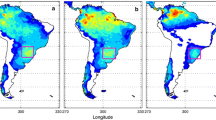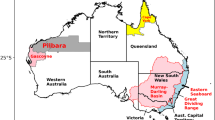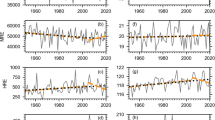Abstract
The main goal of this study is to describe the role of synoptic and intraseasonal anomalies during the life cycle of summer rainfall extremes over South America. Eastward-propagating synoptic-scale midlatitude waves are the main drivers of extreme precipitation events south of the Amazon and their interaction with intraseasonal anomalies over South America is important for heavy rainfall over the South Atlantic convergence zone (SACZ) region and the La Plata basin. Madden–Julian Oscillation (MJO) convective activity in the western Pacific (phases 6 and 7) leads 31 out of 81 extremes over the SACZ region by nearly 10 days. The connection between the MJO and rainfall extremes in other regions is less robust. During El Niño seasons extremes are more frequent in the La Plata basin, with decreased importance of intraseasonal anomalies. Precipitation extremes over the La Plata basin tend to be less frequent and also shorter during La Niña summers and, consequently, less hazardous. In the SACZ and the southeastern Brazilian coast, heavy rainfall is also more frequent under El Niño conditions, while La Niña episodes also increase extreme events in the southeastern coast. Extremes over the southeastern coast during El Niños are favored by strong intraseasonal anomalies flanking the subtropical jet, while during La Niñas intraseasonal anomalies are not significant.













Similar content being viewed by others
References
Berbery EH, Nogués-Paegle J, Horel JD (1992) Wave-like extratropical Southern Hemisphere teleconnections. J Atmos Sci 49:155–177
Carvalho LMV, Jones C, Liebmann B (2002) Extreme precipitation events in southeastern South America and large-scale convective patterns in the South Atlantic convergence zone. J Clim 15:2377–2394
Carvalho LMV, Jones C, Liebmann B (2004) The South Atlantic convergence zone: intensity, form, persistence, relationships with intraseasonal to interannual activity and extreme rainfall. J Clim 17:88–108
Cavalcanti IFA (2012) Large-scale and synoptic features associated with extreme precipitation over South America: a review and case studies for the first decade of the 21st century. Atmos Res 118:27–40
Chen M, Shi W, Xie P, Silva VBS, Kousky VE, Higgins RW, Janowiak JE (2008) Assessing objective techniques for gauge-based analyses of global daily precipitation. J Geophys Res. doi:10.1029/2007JD009132
Cunningham CC, Cavalcanti IFA (2006) Intraseasonal modes of variability affecting the South Atlantic convergence zone. Int J Climatol 26:1165–1180
Dolif G, Nobre CA (2012) Improving extreme precipitation forecasts in Rio de Janeiro, Brazil: are synoptic patterns efficient for distinguishing ordinary from heavy rainfall episodes? Atmos Sci Lett 13:216–222
Gan MA, Rao VB (1994) The influence of the Andes Cordillera on transient disturbances. Mon Weather Rev 122:1141–1157
Garreaud RD (2000) Cold air incursions over subtropical South America: mean structure and dynamics. Mon Weather Rev 128:2544–2559
Garreaud RD, Wallace JM (1998) Summertime incursions of midlatitude air into subtropical and tropical South America. Mon Weather Rev 126:2713–2733
Grimm AM, Ambrizzi T (2009) Teleconnections into South America from the tropics and extratropics on interannual and intraseasonal timescales. In: Vimeux F, Sylvetre F, Khodri M (eds) Past climate variability in South America and surrounding regions, 1st edn. Springer, Netherlands, pp 159–191
Grimm AM, Silva Dias PL (1995) Analysis of tropical-extratropical interaction with influence functions of a barotropic model. J Atmos Sci 52:3538–3555
Grimm AM, Tedeschi RG (2009) ENSO and extreme rainfall events in South America. J Clim 22:1589–1609
Jones C, Waliser DE, Lau KM, Stern W (2004) Global occurrences of extreme precipitation and the Madden–Julian oscillation: observations and predictability. J Clim 17:4575–4589
Kalnay E, Kanamitsu M, Kistler R, Collins W, Deaven D, Gandin L, Iredell M, Saha S, Woollen J, Zhu Y, Chelliah M, Ebisuzaki W, Higgins W, Janowiak J, Mo KC, Ropelewski C, Wang J, Leetma A, Reynolds R, Jenne R, Joseph D (1996) The NCEP/NCAR 40 year reanalysis project. Bull Am Meteorol Soc 77:437–471
Liebmann B, Smith CA (1996) Description of a complete (interpolated) outgoing longwave radiation dataset. Bull Am Meterol Soc 77:1275–1277
Liebmann B, Kiladis GN, Marengo JA, Ambrizzi T, Glick JD (1999) Submonthly convective variability over South America and the South Atlantic convergence zone. J Clim 12:1877–1891
Liebmann B, Kiladis GN, Vera CS, Saulo AC, Carvalho LMV (2004) Subseasonal variations of rainfall in South America in the vicinity of the low-level jet east of the Andes and comparison to those in the South Atlantic convergence zone. J Clim 17:3829–3842
Lima K, Satyamurti P, Fernandez JPR (2010) Large-scale atmospheric conditions associated with heavy rainfall episodes in Southeast Brazil. Theor Appl Climatol 101:121–135
Livezey RE, Chen WY (1983) Statistical field signficance and its determination by Monte Carlo techniques. Mon Weather Rev 111:46–59
Mo KC, Nogués-Paegle J (2001) The Pacific–South American modes and their downstream effects. Int J Climatol 21:1211–1229
Nogués-Paegle J, Mo KC (1997) Alternating wet and dry conditions over South America during summer. Mon Weather Rev 125:279–291
Nogués-Paegle J, Byerle LA, Mo KC (2000) Intraseasonal modulation of South American summer precipitation. Mon Weather Rev 128:837–850
Pereira A, Carbone RE, Janowiak JE, Arkin P, Hallak R, Ramos CGM (2010) Satellite rainfall estimates over South America—possible applicability to the water management of large watersheds. J Am Water Resour Assoc 46:344–360
Ramírez MCV, Ferreira NJ, Velho HFC (2006) Linear and nonlinear downscalling for rainfall forecasting over southeastern Brazil. Weather Forecast 21:969–989
Seluchi ME, Chou SC (2009) Synoptic patterns associated with landslide events in Serra do Mar. Brazil Theor Appl Climatol 98:67–77
Silva VBS, Berbery EH (2006) Intense rainfall events affecting the La Plata basin. J. Hydrometeor. 7:769–787
Teixeira MS, Satyamurty P (2007) Dynamical and synoptic characteristics of heavy rainfall episodes in Southern Brazil. Mon Weather Rev 135:598–617
Weaver SJ, Wang W, Chen M, Kumar A (2011) Representation of MJO variability in the NCEP climate forecast system. J Clim 24:4676–4694
Webster PJ, Chang H-R (1988) Energy accumulation and emanation regions at low latitudes: impacts of a zonally varying basic state. J Atmos Sci 45:803–829
Webster PJ, Hoyos CD (2004) Prediction of monsoon rainfall and river discharge on 15–30 day time scales. Bull Am Meterol Soc 85:1745–1765
Wheeler MC, Hendon HH (2004) An all-season real-time multivariate MJO index: development of an index for monitoring and prediction. Mon Weather Rev 132:1917–1932
Widlansky MJ, Webster PJ, Hoyos CD (2011) On the location and orientation of the South Pacific convergence zone. Clim Dyn 36:561–578
Zipser EJ, Cecil DJ, Liu C, Nesbitt SW, Yorty DP (2006) Where are the most intense thunderstorms on earth? Bull Am Meteorol Soc 87:1058–1071
Acknowledgments
This work was carried out with the support of the National Council for Scientific and Technological Development (CNPq-Brazil) Grant BJT 400547/2013-9, and with the aid of the Inter-American Institute for Global Change Research (IAI) Grant CRN3035, which is supported by the US National Science Foundation (Grant GEO-1128040).
Author information
Authors and Affiliations
Corresponding author
Rights and permissions
About this article
Cite this article
Hirata, F.E., Grimm, A.M. The role of synoptic and intraseasonal anomalies in the life cycle of summer rainfall extremes over South America. Clim Dyn 46, 3041–3055 (2016). https://doi.org/10.1007/s00382-015-2751-6
Received:
Accepted:
Published:
Issue Date:
DOI: https://doi.org/10.1007/s00382-015-2751-6




